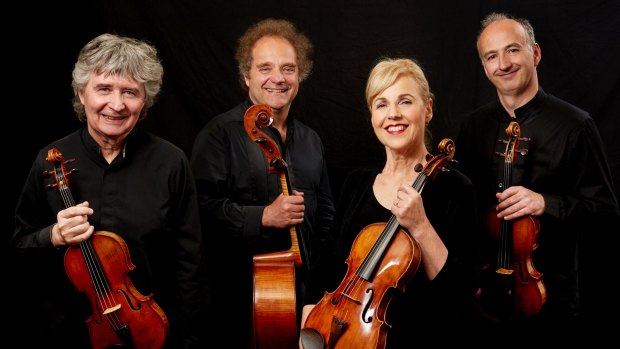By Peter McCallum
Beethoven and Bruckner. Sydney Symphony Orchestra. Simone Young. Imogen Cooper. Opera House. August 18.
★★★★
Takacs Quartet. Musica Viva. City Recital Hall. August 19
★★★★

Refined and sensitive: The Takacs Quartet delivered a characteristic performance. Credit: Keith Saunders
Bruckner's Fifth Symphony is arguably the most monumental and least comfortable of his symphonies.
Its 75 minute quest is full of imposing moments and glorious orchestral sound but also uncompromising contrasts and stern silences.
The slow introduction of the SSO's performance under Simone Young had steady tread without portentous tension, its ideas presented with clear definition, un-nuanced by overt expressiveness.
Like many of Bruckner's symphonies, the slow movement alternates two ideas. First, a solemn oboe melody, holding its own implacably against complicating cross rhythm, and then a section for strings where human warmth finally appears.
The finale works its way through fugues like devotional exercises and it is only when a magnificent brass chorale blazes out in the last bars that one realises the whole symphony is devoted to building an edifice on which to place that moment.
In the first half, Imogen Cooper played Beethoven's Piano Concerto No.2 in B flat with authoritative musicality, the ideas shaped not by whim but by straightforward clarity and musical insight.
She played the extended cadenza Beethoven wrote 14 years after the concerto was written, drawing the youthful lightness of the piece into the more involved development of his subsequent style.
The Takacs Quartet's Saturday afternoon for Musica Viva, featured a new work, the String Quartet No.6 Child's Play by Carl Vine, Musica Viva's artistic director.
As with his recent Trombone Concerto, Five Hallucinations, the five movements offer didactic reflection, in this case on the clarity of the child's view.
The first movement, Play, had amiable liveliness, while Concentration represented the child's furrowed brow as the masterpiece is constructed.
A nagging idea in Friendship brought to mind those children who express their affection by unpremeditated tickling attacks. Sleep was touchingly punctuated by heavy breathing near me in the audience, but the finale, Running, was heard with enthusiastic attentiveness.
It took a little while for the intonation to settle in the first movement of Haydn's String Quartet in D major, Opus 76, No.5 but the second movement, Largo cantabile e mesto, where Arcadian serenity is accompanied by remarkable harmonic adventurousness was quintessential Takacs playing, full of engaged musical refinement and sensitivity.
In Dvorak's String Quartet No.14 in A-flat major, Opus 105 the players combined a mood of golden sunniness with momentary nagging thoughts in inner parts to create an optimistic tone of psychological sophistication and complexity.